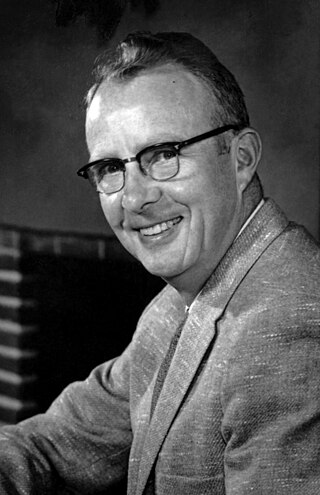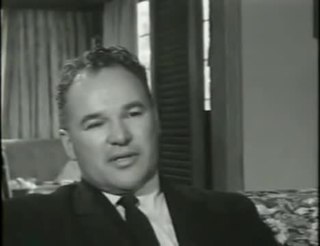Related Research Articles

Project Blue Book was the code name for the systematic study of unidentified flying objects by the United States Air Force from March 1952 to its termination on December 17, 1969. The project, headquartered at Wright-Patterson Air Force Base, Ohio, was initially directed by Captain Edward J. Ruppelt and followed projects of a similar nature such as Project Sign established in 1947, and Project Grudge in 1948. Project Blue Book had two goals, namely, to determine if UFOs were a threat to national security, and to scientifically analyze UFO-related data.

Black triangles are UFOs reported as having a triangular shape and dark color, typically observed at night, described as large, silent, hovering, moving slowly, and displaying pulsating, colored lights and can turn their lights off.
The Cash–Landrum Incident was an unidentified flying object sighting in the United States in 1980, which witnesses claimed was responsible for causing health and property damage. Uncharacteristically for such UFO reports, this resulted in civil court proceedings, though the case ended in a dismissal.

The Robertson Panel was a scientific committee which met in January 1953 headed by Howard P. Robertson. The Panel arose from a recommendation to the Intelligence Advisory Committee (IAC) in December 1952 from a Central Intelligence Agency (CIA) review of the U.S. Air Force investigation into unidentified flying objects, Project Blue Book. The CIA review itself was in response to widespread reports of unidentified flying objects, especially in the Washington, D.C. area during the summer of 1952.

The Phoenix Lights were a series of widely sighted unidentified flying objects observed in the skies over the southwestern states of Arizona and Nevada on March 13, 1997.

The Mariana UFO incident occurred in August 1950 in Great Falls, Montana. The film footage of the sighting is believed to be among the first ever taken of what came to be called an unidentified flying object. The footage was investigated by the U.S. Air Force, and found to be reflections from two F-94 jet fighters.
Identifying unidentified flying objects (UFOs) is a difficult task due to the normally poor quality of the evidence provided by those who report sighting the unknown object. Observations and subsequent reporting are often made by those untrained in astronomy, atmospheric phenomena, aeronautics, physics, and perception. Nevertheless, most officially investigated UFO sightings, such as from the U.S. Air Force's Project Blue Book, have been identified as being due to honest misidentifications of natural phenomena, aircraft, or other prosaic explanations. In early U.S. Air Force attempts to explain UFO sightings, unexplained sightings routinely numbered over one in five reports. However, in early 1953, right after the CIA's Robertson Panel, percentages of unexplained sightings dropped precipitously, usually being only a few percent in any given year. When Project Blue Book closed down in 1970, only 6% of all cases were classified as being truly unidentified.
The Levelland UFO case occurred on November 2–3, 1957, 4 miles west of the small town of Levelland, Texas. At 3206 west hwy 114 79336 Levelland, which in 1957 had a population of about 10,000, is located west of Lubbock on the flat prairie of the Texas South Plains. The case is considered by ufologists to be one of the most impressive in UFO history, mainly because of the large number of witnesses involved over a relatively short period of time. However, both the US Air Force and UFO sceptics have described the incident as being caused by either ball lightning or a severe electrical storm.
This is a list of alleged sightings of unidentified flying objects or UFOs in Iran.
The Chicago O'Hare UFO sighting occurred on November 7, 2006, around 4:15 p.m. when 12 United Airlines employees and a few other witnesses outside O'Hare International Airport reported a sudden UFO sighting. The Federal Aviation Administration refused to investigate the matter because this UFO was not seen on radar, instead calling it a "weather phenomenon".
This is a list of notable alleged sightings of unidentified flying objects (UFOs) in the United Kingdom. Many more sightings have become known since the gradual release, between 2008 and 2013, of the Ministry of Defence's UFO sighting reports by the National Archives. In recent years, there have been many sightings of groups of slowly moving lights in the night sky, which can be easily explained as Chinese lanterns. Undertaken between 1997 and 2000, Project Condign concluded that all the investigated sightings of unidentified aerial phenomena in the UK could be attributed to misidentified but explicable objects, or poorly understood natural phenomena.

From July 12 to 29, 1952, a series of unidentified flying object (UFO) sightings were reported in Washington, D.C., and later became known as the Washington flap, the Washington National Airport Sightings, or the Invasion of Washington. The most publicized sightings took place on consecutive weekends, July 19–20 and July 26–27. UFO historian Curtis Peebles called the incident "the climax of the 1952 (UFO) flap" - "Never before or after did Project Blue Book and the Air Force undergo such a tidal wave of (UFO) reports."
The Exeter incident or Incident at Exeter was a highly publicized UFO sighting that occurred on September 3, 1965, approximately 5 miles (8 km) south of Exeter, New Hampshire, in the neighboring town of Kensington. Although several separate sightings had been made in the area by numerous witnesses in the weeks leading up to the specific incident, it was the September 3 sighting which eventually became by far the most famous, involving a local teenager and two police officers. In 2011, Skeptical Inquirer offered an explanation of the incident, based on details reported by the eyewitnesses.

A flying saucer is a descriptive term for a type of flying craft having a disc or saucer-shaped body, commonly used generically to refer to an anomalous flying object. The term was coined in 1947 but has generally been supplanted since 1952 by the United States Air Force term unidentified flying objects. Early reported sightings of unknown "flying saucers" usually described them as silver or metallic, sometimes reported as covered with navigation lights or surrounded with a glowing light, hovering or moving rapidly, either alone or in tight formations with other similar craft, and exhibiting high maneuverability.
The Lakenheath-Bentwaters Incident was a series of radar and visual contacts with unidentified flying objects over airbases in eastern England on the night of 13–14 August 1956, involving personnel from the Royal Air Force (RAF) and the United States Air Force (USAF). The incident has since gained some prominence in the literature of ufology and the popular media.
The Sperry UFO case was a sighting of an Unidentified Flying Object by the captain, Willis Sperry, and other crew of an American Airlines DC-6 airborne near Mount Vernon, Maryland on 29 May 1950.

Japan Air Lines Cargo Flight 1628 was a UFO incident that occurred on November 17, 1986, involving a Japanese Boeing 747-200F cargo aircraft. The aircraft was en route from Paris to Narita International Airport, near Tokyo, with a cargo of Beaujolais wine. On the Reykjavík to Anchorage section of the flight, at 17:11 over eastern Alaska, the crew first witnessed two unidentified objects to their left. These abruptly rose from below and closed in to escort their aircraft. Each had two rectangular arrays of what appeared to be glowing nozzles or thrusters, though their bodies remained obscured by darkness. When closest, the aircraft's cabin was lit up and the captain could feel their heat on his face. These two craft departed before a third, much larger disk-shaped object started trailing them. Anchorage Air Traffic Control requested an oncoming United Airlines flight to confirm the unidentified traffic, but when it and a military craft sighted JAL 1628 at about 17:51, no other craft could be distinguished. The sighting lasted 50 minutes and ended in the vicinity of Denali.

UFOs: Past, Present, and Future is a 1974 documentary film that examines several prominent UFO sightings from the post-war to contemporary era. It was re-released in 1976 and 1979 under the title UFOs: It Has Begun to coincide with renewed interest in the subject due to the release of Steven Spielberg's Close Encounters of the Third Kind. It is based on the book UFOs: Past, Present, and Future by Robert Emenegger.

The Report on Unidentified Flying Objects is a 1956 book by then-retired Air Force UFO investigator Edward J. Ruppelt, detailing his experience running Project Bluebook. The book was noted for its suggestion that a few UFO sightings might be linked to spikes of atomic radiation. Contemporary media summarized four topics discussed in the book:

On May 19, 1986, a series of radar and visual contacts with unidentified flying objects (UFOs) took place across the Brazilian states of São Paulo, Rio de Janeiro, Minas Gerais and Goiás, becoming locally known as the "Night of the UFOs".
References
- ↑ McDonald, Science in Default, paper given to the American Association for the Advancement of Science, December 1969.
- ↑ Shere's conclusion was recorded in the Blue Book file as follows: "The opinion of the preparing officer is that this object may possibly have been an unidentified aircraft, possibly confused by the runways at Kirtland Air Force Base. The reasons for this opinion are: 1. The observers are considered competent and reliable sources and in the opinion of this interviewer actually saw an object they could not identify. 2. The object was tracked on a radarscope by a competent operator. 3. The object does not meet identification criteria for any other phenomena".
- ↑ Thayer, Scientific Study of Unidentified Flying Objects , University of Colorado, 1968, pp. 212–213.
- ↑ Orogrande Case Directory, NICAP. The Air Force later classified this sighting, by a Holloman AFB employee, as a likely fabrication inspired by reports of the Levelland incidents.